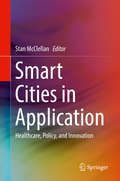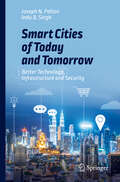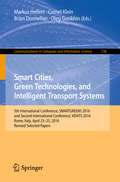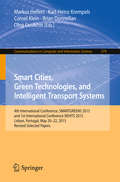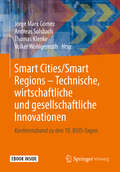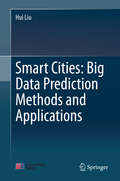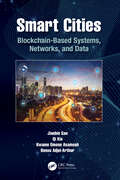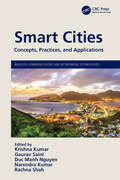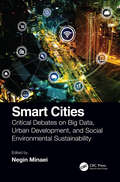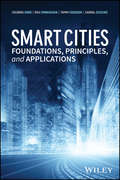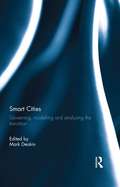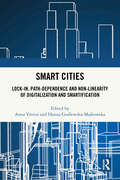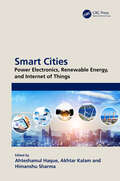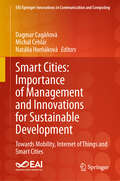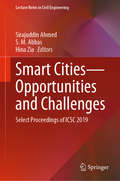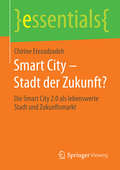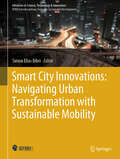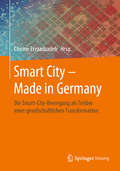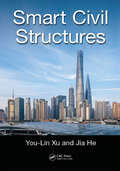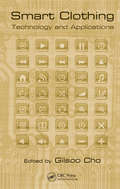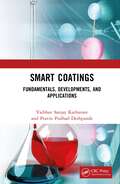- Table View
- List View
Smart Cities in Application: Healthcare, Policy, and Innovation
by Stan McClellanThis book explores categories of applications and driving factors surrounding the Smart City phenomenon. The contributing authors provide perspective on the Smart Cities, covering numerous applications and classes of applications. The book uses a top-down exploration of the driving factors in Smart Cities, by including focal areas including “Smart Healthcare,” “Public Safety & Policy Issues,” and “Science, Technology, & Innovation.” Contributors have direct and substantive experience with important aspects of Smart Cities and discuss issues with technologies & standards, roadblocks to implementation, innovations that create new opportunities, and other factors relevant to emerging Smart City infrastructures.Features an exploration of Smart City issues and solutions from a variety of stakeholders in the evolving fieldPresents conversational, nuanced, and forward thinking perspectives on Smart Cities, their implications, limitations, obstacles, and opportunitiesIncludes contributions from industry insiders who have direct, relevant experience with their respective subjects as well as positioning and corporate stature
Smart Cities of Today and Tomorrow: Better Technology, Infrastructure and Security
by Joseph N. Pelton Indu B. SinghHackers, cyber-criminals, Dark Web users, and techno-terrorists beware! This book should make you think twice about attempting to do your dirty work in the smart cities of tomorrow.Scores of cities around the world have begun planning what are known as “smart cities.” These new or revamped urban areas use the latest technology to make the lives of residents easier and more enjoyable.They will have automated infrastructures such as the Internet of Things, “the Cloud,” automated industrial controls, electronic money, mobile and communication satellite systems, wireless texting and networking. With all of these benefits come new forms of danger, and so these cities will need many safeguards to prevent cyber criminals from wreaking havoc. This book explains the advantages of smart cities and how to design and operate one. Based on the practical experience of the authors in projects in the U.S. and overseas in Dubai, Malaysia, Brazil and India, it tells how such a city is planned and analyzes vital security concerns that must be addressed along the way.Most of us will eventually live in smart cities. What are the advantages and the latest design strategies for such ventures? What are the potential drawbacks? How will they change the lives of everyday citizens? This book offers a preview of our future and how you can help prepare yourself for the changes to come.
Smart Cities to Smart Societies: Moving Beyond Technology (Routledge Studies in Sustainability)
by Elie Azar Imad Antoine Ibrahim Esmat ZaidanThis book explores the governance of smart cities from a holistic approach, arguing that the creation of smart cities must consider the specific circumstances of each country to improve the preservation, revitalisation, liveability, and sustainability of urban areas. The recent push for smart cities is part of an effort to reshape urban development through megaprojects, centralised master planning, and approaches that convey modernism and global affluence. However, moving towards a citywide smart transition is a major undertaking, and complexities are expected to grow exponentially. This book argues that a comprehensive approach is necessary to consider all relevant aspects. The chapters seek to identify the potential and pitfalls of the smart transformation of urban communities and its role in sustainability goals; share state-of-the-art practices concerning technology, policy, and social science dimensions in smart cities and communities; and develop opportunities for cooperation and partnership in wider and larger research and development programmes. Divided into three parts, the first part of the book highlights the significance of various societal elements and factors in facilitating a successful smart transition, with a particular emphasis on the role of human capital. The second part delves into the challenges associated with technology and its integration into smart city initiatives. The final part of the book examines the current state of regulations and policies governing smart cities. The book will be an important asset for students and researchers studying law, engineering, political science, international relations, geopolitics, economics, and engineering.
Smart Cities, Green Technologies, and Intelligent Transport Systems
by Markus Helfert Brian Donnellan Cornel Klein Oleg GusikhinThis book constitutes the thoroughly refereedproceedings of the 4th International Conference on Smart Cities and Green ICTSystems, SMARTGREENS 2015, and the 1st InternationalConference on Vehicle Technology and Intelligent Transport Systems, VEHITS2015, held in Lisbon, Portugal, in May 2015. The 15 full papers of SMARTGREENS 2015 presentedwere carefully reviewed and selected from 73 submissions. VEHITS 2015 received27 paper submissions from which 3 papers were selected and published in thisbook. The papers reflect topics such as smart cities, energy-aware systems andtechnologies, sustainable computing and communications, sustainabletransportation and smart mobility.
Smart Cities, Green Technologies, and Intelligent Transport Systems: 4th International Conference, Smartgreens 2015, And 1st International Conference Vehits 2015, Lisbon, Portugal, May 20-22, 2015, Revised Selected Papers (Communications In Computer And Information Science #579)
by Markus Helfert Karl-Heinz Krempels Brian Donnellan Cornel Klein Oleg GusikhinThis book constitutes the thoroughly refereedproceedings of the 4th International Conference on Smart Cities and Green ICTSystems, SMARTGREENS 2015, and the 1st InternationalConference on Vehicle Technology and Intelligent Transport Systems, VEHITS2015, held in Lisbon, Portugal, in May 2015. The 15 full papers of SMARTGREENS 2015 presentedwere carefully reviewed and selected from 73 submissions. VEHITS 2015 received27 paper submissions from which 3 papers were selected and published in thisbook. The papers reflect topics such as smart cities, energy-aware systems andtechnologies, sustainable computing and communications, sustainabletransportation and smart mobility.
Smart Cities/Smart Regions – Technische, wirtschaftliche und gesellschaftliche Innovationen: Konferenzband zu den 10. BUIS-Tagen
by Jorge Marx Gómez Volker Wohlgemuth Andreas Solsbach Thomas KlenkeIn diesem Tagungsband zu den 10. BUIS-Tagen (20. Tagung der Fachgruppe Betriebliche Umweltinformationssysteme der Gesellschaft für Informatik e. V.) werden Thematiken „smarter“ Städte und Regionen unter Einsatz von nachhaltigen IKT-Lösungen in Beiträgen aus Wissenschaft und Praxis vorgestellt. Betriebliche Umweltinformationssysteme erfassen, analysieren und stellen hierbei umweltrelevante Daten für vielschichtige Prozesse bereit. Das Spektrum der Fachbeiträge zeigt die Vielfalt der Fragestellungen und den Einsatz von IKT-Lösungen in der Förderung der Ziele für eine nachhaltige Entwicklung auf. Wesentlichen Raum nehmen Beiträge zur Wissenschaftskooperation und zum Erfahrungstransfer zwischen afrikanischen und europäischen Wissenschaftlerinnen und Wissenschaftlern auf allen Themenfeldern der Tagung ein.
Smart Cities: A Data Analytics Perspective (Lecture Notes in Intelligent Transportation and Infrastructure)
by Mohammad Ayoub Khan Mohammad Tabrez Quasim Fahad AlgarniThis book offers practical as well as conceptual knowledge of the latest trends, tools, techniques and methodologies of data analytics in smart cities. The smart city is an advanced technological area that is capable of understanding the environment by examining the data to improve the livability. The smart cities allow different kinds of wireless sensors to gather massive amounts, full speed and a broad range of city data. The smart city has a focus on data analytics facilitated through the IoT platforms. There is a need to customize the IoT architecture and infrastructures to address needs in application of specific domains of smart cities such as transportation, traffic, health and, environment. The smart cities will provide next generation development technologies for urbanization that includes the need of environmental sustainability, personalization, mobility, optimum energy utilization, better administrative services and higher quality of life. Each chapter presents the reader with an in-depth investigation regarding the possibility of data analytics perspective in smart cities. The book presents cutting-edge and future perspectives of smart cities, where industry experts, scientists, and scholars exchange ideas and experience about surrounding frontier technologies, breakthrough and innovative solutions and applications.
Smart Cities: Big Data Prediction Methods and Applications
by Hui LiuSmart Cities: Big Data Prediction Methods and Applications is the first reference to provide a comprehensive overview of smart cities with the latest big data predicting techniques. This timely book discusses big data forecasting for smart cities. It introduces big data forecasting techniques for the key aspects (e.g., traffic, environment, building energy, green grid, etc.) of smart cities, and explores three key areas that can be improved using big data prediction: grid energy, road traffic networks and environmental health in smart cities. The big data prediction methods proposed in this book are highly significant in terms of the planning, construction, management, control and development of green and smart cities. Including numerous case studies to explain each method and model, this easy-to-understand book appeals to scientists, engineers, college students, postgraduates, teachers and managers from various fields of artificial intelligence, smart cities, smart grid, intelligent traffic systems, intelligent environments and big data computing.
Smart Cities: Blockchain-Based Systems, Networks, and Data
by Jianbin Gao Qi Xia Kwame Omono Asamoah Bonsu Adjei-ArthurSmart Cities: Blockchain-Based Systems, Networks, and Data examines the various components that make up a smart city. It focuses on infrastructure, processes, and services and outlines approaches for services such as health, transport, energy, and more. With an underlying emphasis on blockchain networks, the authors examine ways to provide the management of resources and activities by creating a more secure and trustless operating systems where resources are more effectively allocated and managed. Features • Novel approaches toward the provision of smart city services • Detailed explanations of how a blockchain-based smart city network operates • Novel design and architecture for cutting-edge technologies such as energy systems and vehicular devices interacting with blockchain across smart cities • Monitoring of data flow and the movement of several data types across different components of a smart city • Comprehensive analysis of issues affecting entities across a smart city and the effects of blockchain-based solutions This book is a practical and detailed demonstration for researchers and industry professionals who would use blockchain technology for effective city management.
Smart Cities: Concepts, Practices, and Applications (Wireless Communications and Networking Technologies)
by Krishna Kumar Narendra Kumar Gaurav Saini Duc Manh Nguyen Rachna ShahThis book discusses the various aspects of smart cities and their architecture along with the application of the latest technologies, including the Internet of Things (IoT) and artificial intelligence (AI). The concept of smart cities, their development, technological advancements, and issues related to them are discussed in detail.Smart Cities: Concepts, Practices, and Applications covers numerous topics, including energy utilities and the role of renewable energy for sustainable development, intelligent transport systems, traffic management, sewage and waste management, the impact of smart city development on the social and economic aspects of life, flexible communication technologies utilized in the development of smart cities, e-governance challenges, and implementation in smart cities.FEATURES Discusses the basic architecture of a smart city and its development concept Covers the application of IoT and AI in the development of smart cities Examines the impact of smart city development on social and economic aspects Presents comprehensively intelligent transport systems and traffic management This book will be useful for senior undergraduate and graduate students and professionals in electrical engineering, electronics and communication engineering, computer science, and civil engineering.
Smart Cities: Critical Debates on Big Data, Urban Development and Social Environmental Sustainability
by Negin MinaeiIn the age of global climate change, society will require cities that are environmentally self-sufficient, able to withstand various environmental problems and recover quickly. It is interesting to note that many "smart" solutions for cities are leading to an unsustainable future, including further electrification, an increased dependence on the Internet, Internet of Things, Big Data, and Artificial Intelligence, and basically any technology that leads us to consume more electricity. This book examines critical topics in Smart Cities such as true sustainability and the resilience required for all cities. It explores sustainability issues in agriculture and the role of agri-technology for a sustainable future, including a city’s ability to locally produce food for its residents. Features: Discusses safety, security, data management, and privacy issues in Smart Cities Examines the various emerging forms of transportation infrastructure and new vehicle technology Considers how energy efficiency can be achieved through behavioral change through specific building operations Smart Cities: Critical Debates on Big Data, Urban Development and Social Environmental Sustainability brings awareness to professionals working in the fields of environmental, civil, and transportation engineering, urban planners, and political leaders about different environmental aspects of Smart Cities and refocuses attention on critical urban infrastructure that will be necessary to respond to future challenges including climate change, food insecurity, natural hazards, energy production, and resilience.
Smart Cities: Foundations, Principles, and Applications
by Sabina Jeschke Houbing Song Ravi Srinivasan Tamim SookoorProvides the foundations and principles needed for addressing the various challenges of developing smart cities Smart cities are emerging as a priority for research and development across the world. They open up significant opportunities in several areas, such as economic growth, health, wellness, energy efficiency, and transportation, to promote the sustainable development of cities. This book provides the basics of smart cities, and it examines the possible future trends of this technology. Smart Cities: Foundations, Principles, and Applications provides a systems science perspective in presenting the foundations and principles that span multiple disciplines for the development of smart cities. Divided into three parts—foundations, principles, and applications—Smart Cities addresses the various challenges and opportunities of creating smart cities and all that they have to offer. It also covers smart city theory modeling and simulation, and examines case studies of existing smart cities from all around the world. In addition, the book: Addresses how to develop a smart city and how to present the state of the art and practice of them all over the world Focuses on the foundations and principles needed for advancing the science, engineering, and technology of smart cities—including system design, system verification, real-time control and adaptation, Internet of Things, and test beds Covers applications of smart cities as they relate to smart transportation/connected vehicle (CV) and Intelligent Transportation Systems (ITS) for improved mobility, safety, and environmental protection Smart Cities: Foundations, Principles, and Applications is a welcome reference for the many researchers and professionals working on the development of smart cities and smart city-related industries.
Smart Cities: Governing, Modelling and Analysing the Transition
by Mark DeakinSmart city development has emerged a major issue over the past 5 years. Since the launch of IBM’s Smart Planet and CISCO’s Smart Cities and Communities programmes, their potential to deliver on global sustainable development targets have captured the public’s attention. However, despite this growing interest in the development of smart cities, little has as yet been published that either sets out the state-of-the-art, or which offers a less than subjective, arm’s length and dispassionate account of their potential contribution. This book brings together cutting edge research and the findings from technical development projects from leading authorities within the field to capture the transition to smart cities. It explores what is understood about smart cities, playing particular attention on the governance, modelling and analysis of the transition that smart cities seek to represent. In paving the way for such a representation, the book begins to account for the social capital of smart communities and begins the task of modelling their embedded intelligence through an analysis of what the "embedded intelligence of smart cities" contributes to the sustainability of urban development. This innovative book offers an interdisciplinary perspective and shall be of interest to researchers, policy analysts and technical experts involved in and responsible for the planning, development and design of smart cities. It will also be of particular value to final year undergraduate and postgraduate students interested in Geography, Architecture and Planning.
Smart Cities: Lock-in, Path-dependence and Non-linearity of Digitalization and Smartification (Advances In Science, Technology And Innovation Ser.)
by Anna Visvizi Hanna Godlewska-MajkowskaThis book seeks to identify and to examine factors and mechanisms underlying the growth and development of smart cities.It is commonplace to discuss smart cities through the lens of advances in ICT. The resulting overemphasis on what is technologically possible downplays what is politically, socially and economically feasible. This book, by analysing the smart city through a variety of perspectives, offers a more comprehensive insight into and understanding of the complex and the open-ended nature of the growth and development of a smart city. A solid conceptual framework is developed and employed throughout the chapters, and a selection of case studies from Europe, Asia, and the Arab Peninsula grants the readers a hands-on perspective of the matters discussed.The chapters included in this book address a set of questions, including: How do the twin-processes of digitalization and smartification unfold in the context of the smart city agenda? How do these processes relate to the concepts of smart city 1.0, 2.0., 3.0. and 4.0? In which ways have the spatial aspects of city functioning been influenced by the intrusion of ICT? In which ways do the same processes contribute to the attainment of the UN Sustainable Development Goals (SDGs)? What are the implications of smartification and the emergence of smart organizations (public, private, and voluntary) for the spatial development of smart cities? Do ICT and its application in the city space boost the processes of revitalization and how does ICT influence the process of gentrification? To what extent and how does the intrusion of ICT-enhanced tools and applications in the city space impact on a city’s relationship with its broader territorially defined context? Are the administrative borders and divisions inherent in the fabric of a city becoming less/more porous? How should urban sprawl be conceived in the context of the smart city debate? This book will have a broad appeal to academics, students, and policy makers with interests in urban planning, sustainable development, cities, economics, technology, sociology, urban studies, digitalization, SDGs, wellbeing, and resilience.
Smart Cities: Power Electronics, Renewable Energy, and Internet of Things
by Himanshu Sharma Akhtar Kalam Ahteshamul HaqueThis book discusses the integration of power electronics, renewable energy, and the Internet of Things (IoT) from the perspective of smart cities in a single volume. The text will be helpful for senior undergraduate, graduate students and academic researchers in diverse engineering fields including electrical, electronics and communication, and computers. The book: Covers the integration of power electronics, energy harvesting, and the IoT for smart city applications. Discusses concepts of power electronics and the IoT in electric vehicles for smart cities. Examines the integration of power electronics in renewable energy for smart cities. Discusses important concepts of energy harvesting including solar energy harvesting, maximum power point tracking (MPPT) controllers, and switch-mode power supplies (SMPS). Explores IoT connectivity technologies such as long-term evolution (LTE), narrow band NB-IoT, long-range (LoRa), Bluetooth, and ZigBee (IEEE Standard 802.15.4) for low data rate wireless personal communication applications. The text provides the knowledge about applications, technologies, and standards of power electronics, renewable energy, and IoT for smart cities. It will serve as an ideal reference text for senior undergraduate, graduate students and academic researchers in the fields of electrical engineering, electronics and communication engineering, computer engineering, civil engineering, and environmental engineering.
Smart Cities: Towards Mobility, Internet of Things and Smart Cities (EAI/Springer Innovations in Communication and Computing)
by Dagmar Cagáňová Natália Horňáková Michal CehlárThis book features contributions focusing on innovative technologies influencing industry and connectivity sectors in industrial, urban, social and sustainable development. The contributions cover many topics in mobility, including car manufacturing, e-mobility, smart cities, smart factories (Industry 4.0), smart logistics, social mobility, technological innovations, sustainability, management and marketing, multicultural development, Internet of Things sectors, etc. The contributions are applicable to researchers, academics, students, and professionals.
Smart Cities—Opportunities and Challenges: Select Proceedings of ICSC 2019 (Lecture Notes in Civil Engineering #58)
by Sirajuddin Ahmed S. M. Abbas Hina ZiaThis book comprises select proceedings of the International Conference on Smart Cities: Opportunities and Challenges (ICSC 2019). The book contains chapters based on urban planning and design, policies and financial management, environment, energy, transportation, smart materials, sustainable development, information technologies, data management and urban sociology reflecting the major themes of the conference. The contents focus on current research towards improved governance and efficient management of infrastructure such as water, energy, transportation and housing for sustainable development, economic growth, and improved quality of life, especially for developing nations. This book will be useful for academicians, researchers, and policy makers interested in designing, developing, planning, managing, and maintaining smart cities.
Smart Citizens, Smarter State: The Technologies of Expertise and the Future of Governing
by Beth Simone NoveckGovernments make too little use of the skills and experience of citizens. New tools--what Beth Simone Noveck calls technologies of expertise--are making it possible to match citizen expertise to the demand for it in government. She offers a vision of participatory democracy rooted not in voting or crowdsourcing but in people's knowledge and know-how.
Smart City - Stadt der Zukunft?: Die Smart City 2.0 als lebenswerte Stadt und Zukunftsmarkt (essentials)
by Chirine EtezadzadehDas hier entwickelte Konzept einer lebenswerten Smart City betont die Relevanz der Funktionsfähigkeit und integrierten Resilienz zukunftsfähiger Städte. Die fortschreitende Digitalisierung wird kritisch beleuchtet und der revolutionierte Energiesektor als Fundament des urbanen Lebens erkannt. Das Konzept macht den Menschen und die natürliche Umwelt zum Ausgangspunkt der Betrachtung, was in einem erweiterten Nachhaltigkeitsbegriff und einer ergänzten Produkttheorie resultiert. Die Smart City 2. 0 ist ein Chancenraum für ihre Bewohner und ein attraktiver Zukunftsmarkt für innovative Produkte und Dienstleistungen, doch stellt sie die Akteure und Produktentwickler vor vielfältige Herausforderungen.
Smart City Innovations: Navigating Urban Transformation with Sustainable Mobility (Advances in Science, Technology & Innovation)
by Simon Elias BibriThis book offers a comprehensive exploration of the intersection of urban planning, transportation, technology, and smart city development. With a keen focus on sustainability and the potential for positive change, it presents a collection of diverse chapters that shed light on emerging trends and innovative solutions in the field. The book examines the role of urban ropeways as both a public transport service and a catalyst for touristic development, highlighting their potential benefits and challenges. It also introduces novel approaches to measuring accessibility and transportation potential using Space Syntax and Geographic Information Systems (GIS), providing valuable insights for urban planners and policymakers. The chapters delve into specific areas of study, such as the driving behavior of individuals with high-functioning autism spectrum disorder, the mobility challenges faced by women in developing countries, and alternative methods of snow and ice removal in parkingareas through hydronic heating. Furthermore, the book explores the intersection of sustainability, smart cities, and global travel, considering the impact of aviation on climate change and the potential of digital humanism in the metaverse. It also examines the implications and challenges of cultural biases in smart city development, emphasizing the need for inclusive and culturally sensitive approaches. The integration of Internet of Things (IoT) in housing is discussed, focusing on the domotization of sustainable walls and their potential benefits for energy efficiency and sustainable living. The use of immersive technologies in virtual heritage is explored, showcasing innovative tourist experiences and highlighting the case of the Berati Ethnographic Museum. The book also addresses the potential of web mapping applications for smart city development, the behavioral attitudes toward ridesharing and mode preferences of shared automated electric vehicles, the development of wind turbine systems for vehicle battery recharging, and the application of knowledge-driven problem identification in transformative city design and development. “Smart City Innovations" serves as a valuable resource for researchers, professionals, policymakers, and anyone interested in the future of urban planning, transportation, and smart cities. By addressing pressing challenges and presenting innovative solutions, this book aims to inspire positive change and contribute to the creation of sustainable and livable urban environments.
Smart City – Made in Germany: Die Smart-City-Bewegung als Treiber einer gesellschaftlichen Transformation
by Chirine EtezadzadehDas Buch, das Smart Cities einfach, aber nicht vereinfachend erklärt. Erfahren Sie alles, was Sie über die Licht- und Schattenseiten smarter Entwicklungen wissen müssen und wie eine positive Transformation gelingen kann. Führende deutsche Unternehmen, Verbände, Vereine, Universitäten, Forschungseinrichtungen, Stiftungen, NGO, Startups und Experten sowie Vertreter der Bundes-, Landes- und Kommunalverwaltung erklären qualifiziert, wo wir stehen und was uns bevorsteht.
Smart City: A Critical Assessment (The City Project #6)
by Giovanni Leoni Dario CostiThis contributed volume reports on a multidisciplinary collective work on the topic of Smart City, merging scientific reflections and operational issues. Here, current Smart Cities concepts are subjected to criticism, while the related terminology has been updated to contemplate a model of urban development capable of integrating technical and humanistic culture by fostering an open dialogue between different stakeholders. Upon an introduction to the state of the art, this book presents a glossary of definitions and concepts around the contemporary city, and five interviews with researchers and scholars of different background. The last chapter summarizes current challenges in designing the city of the future, highlighting new research directions in home-infrastructure, small smart city, energy transition, connectivity, digitalization and autonomous and connected mobility.Written by the members of the Scientific Committee of the Smart City 4.0 Sustainable LAB ResearchLaboratory, an inter-university network including research groups from the University of Parma, University of Modena and Reggio Emilia, University of Bologna, University of Ferrara, the Polytechnic University of Milan, and the Catholic University of Milan with its Piacenza campus, this book offers a source of inspiration for other researchers and stakeholders, and it is intended to foster collaborations between different stakeholders - and possibly countries – to develop future cities that are wise, green, sustainable and inclusive.
Smart Civil Structures
by You-Lin Xu Jia HeA smart civil structure integrates smart materials, sensors, actuators, signal processors, communication networks, power sources, diagonal strategies, control strategies, repair strategies, and life-cycle management strategies. It should function optimally and safely in its environment and maintain structural integrity during strong winds, severe earthquakes, and other extreme events. This book extends from the fundamentals to the state-of-the-art. It covers the elements of smart civil structures, their integration, and their functions. The elements consist of smart materials, sensors, control devices, signal processors, and communication networks. Integration refers to multi-scale modelling and model updating, multi-type sensor placement, control theory, and collective placement of control devices and sensors. And the functions include structural health monitoring, structural vibration control, structural self-repairing, and structural energy harvesting, with emphasis on their synthesis to form truly smart civil structures. It suits civil engineering students, professionals, and researchers with its blend of principles and practice.
Smart Clothing: Technology and Applications (Human Factors and Ergonomics)
by Gilsoo ChoGPS-embedded clothing for finding children or skiers when they are lost, bio-monitoring smart shirts, and vests that monitor a patient's vital signs are no longer science fiction but science fact. It is quite likely that within 20 or 30 years, computers, telephones, and televisions will be a part of our intimate clothing. Covering the whole design
Smart Coatings: Fundamentals, Developments, and Applications
by Vaibhav Sanjay Kathavate Pravin Pralhad DeshpandeThis book focuses on fundamentals, technology, synthesis, and characterizations and applied techniques from a practical point of view of coatings. The first three chapters offer a rigorous review of the application of these coatings to corrosion protection in various aerospace and oil and gas industries, and the subsequent chapters present a quick critical review of the state-of-the-art protection techniques of these coatings to novel biomedical applications such as clinical translations and tissue-engineered materials. Environmental, ergonomics, and aesthetic aspects and future perspectives are also explained at the end. Features: Explores the synthesis and application techniques of novel smart coatings in various research areas Presents a concise, critical, and state-of-the-art review of existing research on various types of smart coatings Ascertains the different mechanisms associated with the stimuli response of smart coatings Includes an exclusive chapter on real-time applications in the biomedical field Covers self-healing, self-cleaning, pH balance, early corrosion detection, and triggering mechanisms This book is aimed at researchers and graduate students specifically in smart coatings and thin films and corrosion, including chemical, materials science engineering, industrial and manufacturing engineering, and nanotechnology.
